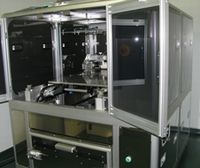 STELLA NEWS SITE is managed by Stella Corporation Inc. |
SEMICON Japan 2022 (December 14-16) |
||||||||||
December 14-16, SEMICON Japan 2022 was held in Tokyo Big Site. Main topics of display in this exhibition are picked up. New oxide target material as a replacement for IGZO target appeared rapidly As concerns material, Kobelco Research Institute exhibited an original oxide target material "KOS-BO3C" for oxide-TFT. It's composed of 3 - 4 elements, competitive with IGZO (InGaZnO) target. Its carrier mobility of pilot produced device (the back channel type) is 29.1 cm2/Vs, which is 3 times and over than that of IGZO-TFT. And also, Vth and SS factor are relatively superior such as 0.5 V and 0.17 V/dec respectively. Furthermore, Vth shift at visible light irradiation can be suppressed lower than that of IGZO-TFT.
It has been used in mass-production line of TFT-LCD and AM-OLED recently because of the above features. By the way, picture 1 (circle type) is useful for semiconductor category. For display use, divided target (tilting of 450 ço width) is de-fact standard at the present moment. Dependence of IPCE on incident light strength is minimized because of original p-type polymer As regards material for solar cell, Toyobo disclosed a polymer type organic film solar cell. It's a bulk-hetero junction device using solution processed light absorption layer, is composed of n-type polymer (PCBM) and an original p-type polymer. Its incident photon-to-current efficiency (IPCE) of pilot-produced device was 10 %.
By the way, the company will release this p-type polymer, and can supply pilot-produced device for estimation of material. Koshibu exhibited a master mold for micro lens film with fine 3D shape structure
It's a glass mold with 3D shape pattern of thick photoresist. If it's used for optical film such as micro lens array film, Ni film is electroformed on this mold by the electroplating method, and then, it is patterned by the nanoimprinting method. The company fabricates thick photoresist pattern. In the booth, large sample same as 400 ü~ 400 ço was exhibited. The company demonstrated to supply large substrate. |
||||||||||
| REMARK STELLA NEWS SITE is a free news site of FPD and PCB by Stella Corporation Inc.(This company does not release these FPD and PCB related products.) |
Novel system was released as manufacturing system of emulsion film mask. |

